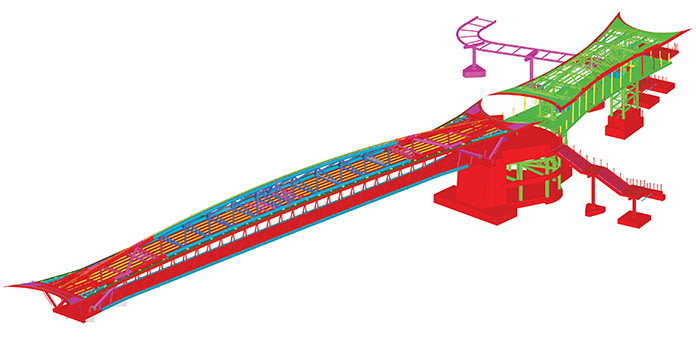Steelwork contractors have been ahead of the curve with digital adoption. Duncan Reed, digital construction process manager at Trimble, looks at the benefits of BIM on steel projects.
The ultimate benefit of incorporating a digital workflow on any steel construction project is the resulting collaborative, coordinated and streamlined approach.
While 2D cannot be wholly disregarded, working without digital technology can be both limiting and isolating, with lack of communication between project parties increasing the likelihood of costly errors occurring. In comparison, BIM provides project teams with data-rich visibility and informed communication from the very start.
To achieve this coordinated approach, we are seeing more projects employing digital, cloud-based platforms, where all data can be stored and made available for project partners to view, discuss and share in one centralised hub.
From a steel fabrication perspective, having some form of information management, dedicated to a fabricator’s unique requirements, is a must.
With such a large amount of design data on a steel construction project, trying to manage stock and fabrication schedules and ensure component traceability throughout production without a digital workflow can be time-consuming. A digital platform can help the fabrication process, ensuring accurate scheduling in accordance with the activity and progress on site.

Digital modelling helped SH Structures plan the steelwork installation for Telford Central Footbridge
Another area of digital technology that is steadily becoming an integrated feature of the construction industry is the use of mixed and virtual reality.
As well as encouraging engagement among all partners, including the end-client and developer, MR and VR can aid improved visibility and project coordination. By overlaying the BIM model in the real-time physical context, the project can be brought to life, allowing the project team to interact with and view the model in levels of detail that 2D simply wouldn’t allow.
Steel contractors can visit a site and, using mixed reality, compare the as-built condition in conjunction with the proposed BIM model, viewing the existing steel structure alongside the proposed new steelwork, and immediately identify any areas of concern.
Mixed-reality technology can also be beneficial for quality control management on a project – particularly at the fabrication and assembly stages. Trimble Connect for HoloLens was recently taken onto the factory floor at industrial steelwork specialist J Wareing & Son, where it was used to view the BIM object and its data overlaid on the fabricated steel joist, to check that all measurements were accurate.
The final phase to consider is the assembly. From site access and delivery schedules to crane locations and assembly logistics, digital technology can help to ensure an efficient and streamlined process. It proved imperative on the recent Telford Central Footbridge project, allowing SH Structures to extract accurate weights of components and the centre of gravity of complex assemblies, all crucial for optimising crane locations.
When considering the role of digital technology on steel construction projects, BIM belongs at the forefront of this discussion. Incorporating a digital workflow has the potential to utterly transform the approach of a construction project, encouraging collaboration, communication and coordination and creating a culture of project partners, rather than subcontractors.













